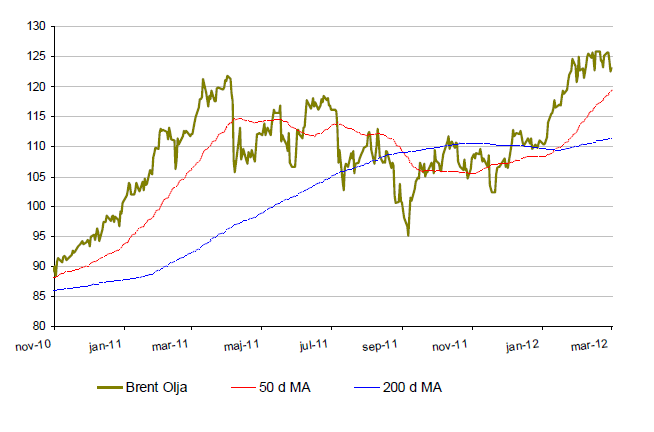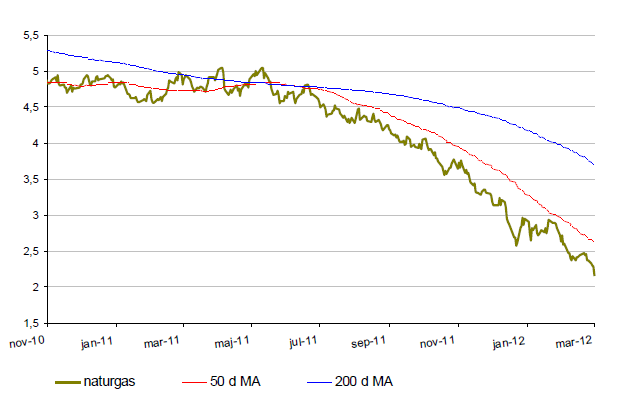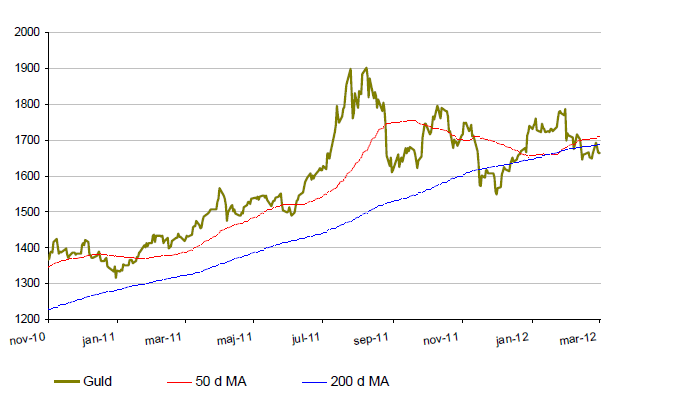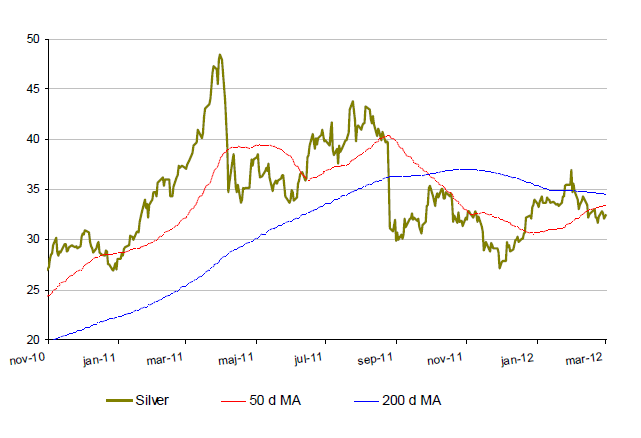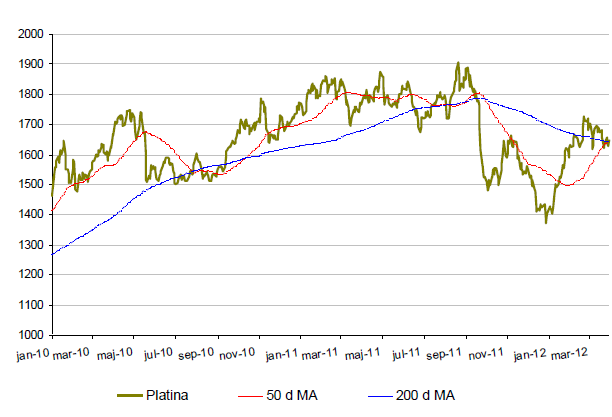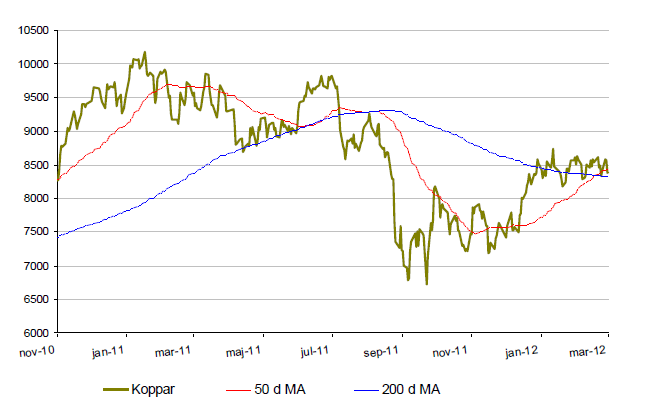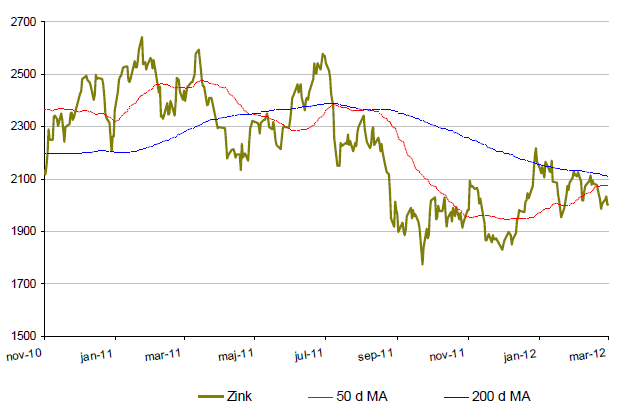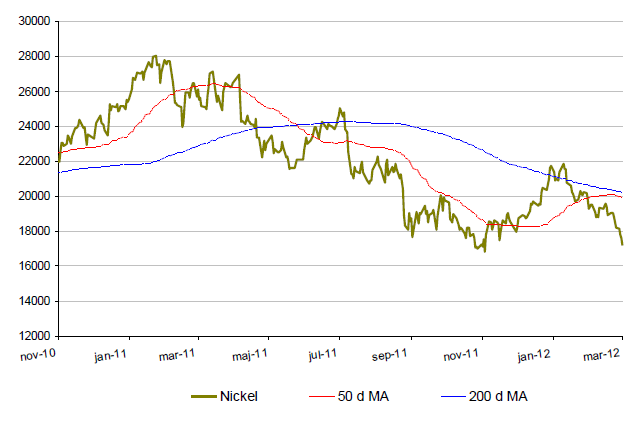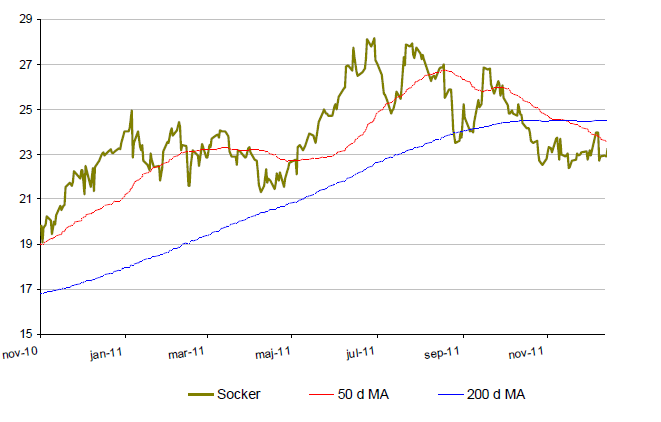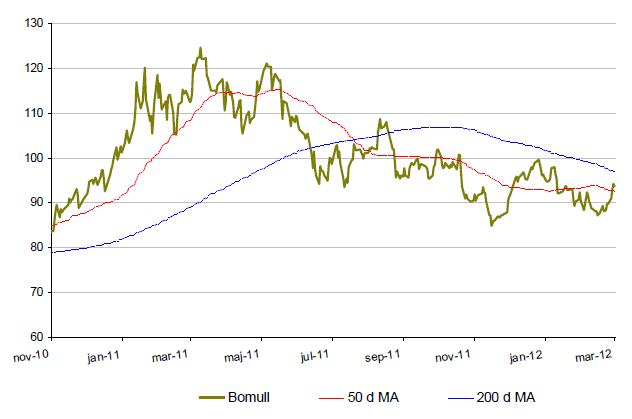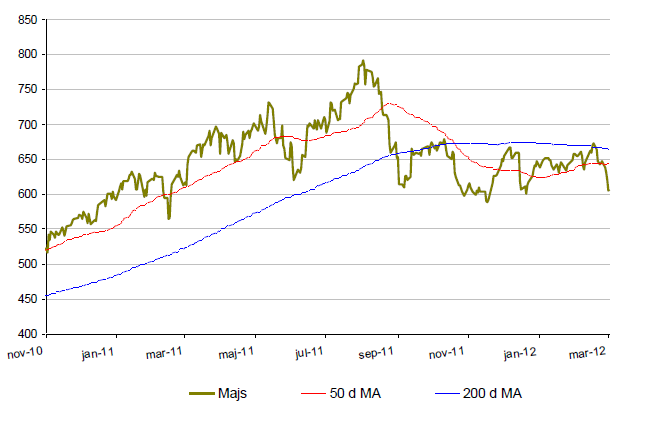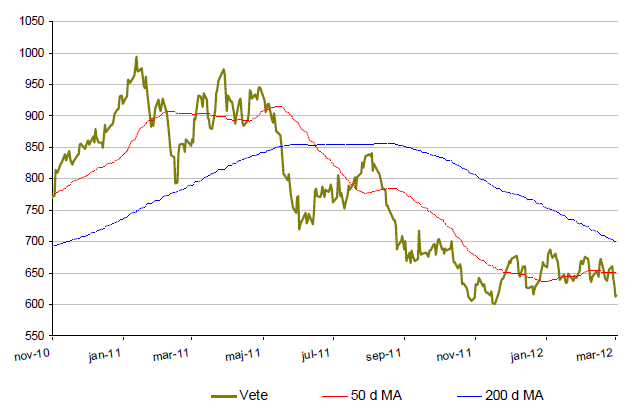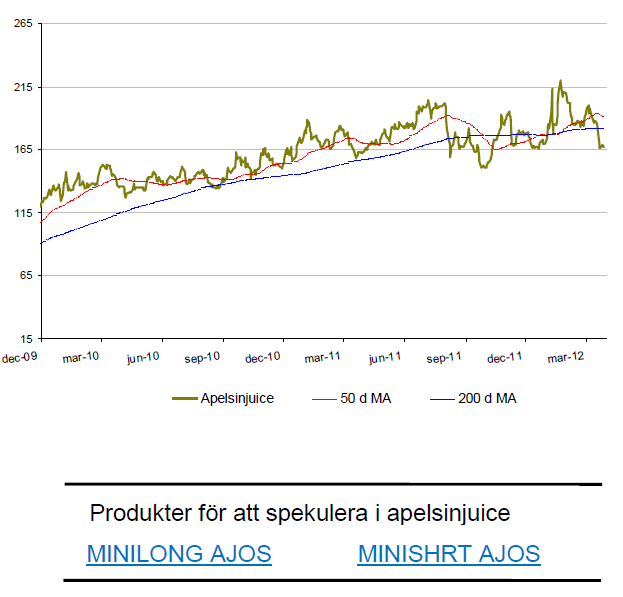Analys
SIP Nordic – Råvaruguiden – April 2012
 Råvaror + aktier blir inte råvaruaktier
Råvaror + aktier blir inte råvaruaktier
Det senaste decenniets uppgång i råvaror har fått investerare att söka sig mot tillgångsslaget. Många vill på något sätt inkludera råvaror i sin portfölj.
Jag är av den tron att en väl sammansatt portfölj bör innehålla en portion råvaror. Hur mycket är upp till var och en att anpassa efter sin riskprofil. Jag anser också att en råvaruexponering bör vara mot råvaror och inget annat. Här skriker nog många till men låt mig förklara.
Det finns många sätt att teoretiskt sett få exponering mot råvaror. Råvaruproducerande länder, såsom Brasilien och Ryssland, kan vara ett sätt att ta del av råvaruprisernas rörelse men det förutsätter ett politiskt, ekonomiskt system som låter intäkterna från råvaror att komma ut i ekonomin. Om detta är verklighet för de två nämnda länderna låter jag vara osagt. Det vanligaste sättet, men också det felaktiga sättet, är investeringar i råvaruaktier. Vad man måste komma ihåg är att investeringar i t.ex. Boliden eller Lundin Mining medför bolagsrisk. Kostnaden för utvinning av många råvaror är i dagsläget mycket högt och pressar vinsterna och lägg också därtill att många råvarubolag verkar i länder med instabila legala system så förstår ni nog var jag vill komma. Råvaruaktier ger, enligt mig, inte en ren exponering mot en viss råvara.
För ett par år sedan stod BP för den största oljekatastrofen i petroleumindustrins historia. Under tre månader flödade olja ut i Mexikanska golfen efter att oljeplattformen Deepwater horizon exploderat. Aktien tappade närmare 60% på väldigt kort tid. Samtidigt som WTI-oljan ”bara” tappade 10%.
Det är en underdrift att säga att den person som investerade i BP för att skapa sig en oljeexponering hade en otrolig otur.
På samma sätt som att oljeinvesteraren hade otur med BP så kan man föra samma resonemang med Lundin Petroleum under hösten 2011. LUPE:s stora fynd av råolja i höstas var för bolaget en supergrej men för brent-oljans pris betydde det ingenting. Oljefyndet skulle räcka till ca 20 dagars global konsumtion.
Det får därmed anses att den person som köpte LUPE för att skapa sig en oljeexponering hade ren och skär bondröta.
Det är viktigt att poängtera att jag inte lägger någon vikt huruvida BP och LUPE är bra bolag som kan genererar avkastning för investeraren. Kontentan är istället att råvaror + aktier inte resulterar i råvaruaktier.
Är ni intresserade av råvaror. Investera då i råvaran och inte aktier.
Råvaror – Energi
Brent olja
- Olja har efter en trevande start i januari både återhämtat sig och nått upp till nya höga nivåer under mars.
- Olja är upp ca.16% upp för året.
- Sedan i början av mars konsoliderar oljan i en kanal mellan 122 och 127 dollar.
- Trots rapporter om ökad tillgång och högre produktion, kyls inte oljepriset ned. Oron i Iran och OPEC länderna bidrar till att oljan behåller sin höga kurs.
- Libyens oljeproduktion börjar smått trappas upp. OPEC ländernas förutspådda produktion för 2012 har däremot sänkts.
Naturgas
- Naturgas närmar sig nu historiskt låga nivåer. Så pass låga att naturgas nu är nere på tio årslägsta.
- De varma temperaturerna i USA vi tidigare skrivit om fortsätter vilket pressar priset på naturgas.
- Naturgas har under året tappat nästan 30%.
- Det låga priset kan tvinga producenter att trappa ned på produktionen vilket kan hjälpa priset på naturgas positivt.
Råvaror – Metaller
Guld
- Summan av världens centralbanker guldpositioner har för första gången på två decennier gått från kort till lång position (spekulerar i uppgång). Detta talar för att guldpriset kan stabilisera sig kring nuvarande nivåer.
- Analytiker tror att centralbankernas guldköp kommer att fortsätta under hela 2012. Totalt räknar analytikerna att centralbanker kommer köpa motsvarande 300 ton guld till under 2012.
- Guld fortsätter att svänga kraftigt men har ökat med ca. 6% för året.
Silver
- Silver har tappat nästan 15% sedan början av Mars men handlas fortfarande på höga nivåer.
- För året är silver upp ca. 19% men har ännu $18 kvar till de höga noteringarna i april förra året.
- Silver befinner sig trots uppgången i en långsiktigt fallande kil.
- Tillgången på fysiskt silver spås minska med 1,5% under 2012 samtidigt som efterfrågan spås öka med 3%
Platina
- Platina har med sin uppgång på ca. 19% för året återhämtat sig rejält och handlas nu på ungefär samma nivåer som guldet.
- Normalt brukar Platinapriset ligga några hundra dollar över guldpriset.
- Strejken i Impala Rustenburg gruvorna i Syd- Afrika, världens största platina gruva, tog slut i mars med det kommer ta tid innan produktionen återgår till det normala.
- Bilindustrin står för den största industriella efterfrågan på platina. Med en stabilare utsikt för bilindustrin följer även högre platinapris.
Koppar
- Koppar har börjat året starkt efter ett ur svagt 2011. Koppar har gått upp ca. 12% i år. (Att jämföra med -21% under 2011)
- Under mars månad har dock kopparpriset stagnerat och konsoliderar nu mellan 8200 och 8750.
- Koppar inventarierna ligger nu på mycket låga nivåer.
- Dagens inventarier räcker enbart i drygt tre veckor. Detta anses oroande då kopparmarknaden behöver en buffert mot produktionsstopp såsom strejken i Freeports gruva i Grasberg i slutet av 2011.
Zink
- Likt koppar har zinkpriset kraftigt stigit under den första månaden av 2012. Zink är upp ca. 7% för året.
- Zinkprisets har dock under mars månad fallit 5% till följd av en mer sund balas i tillgång och efterfrågan.
- Den årliga konsumtionen av zink förväntas växa med 3.6% samtidigt som tillgången bara förväntas växa med 3%. Det uppskattas dock att nuvarande zinktillgång skulle räcka 7,5 veckor, 0,5 veckor längre än 2011.
Nickel
- Nickel presterade sämst av alla basmetaller under 2011.
- Nickel fortsätter sin kräftgång under 2012. Efter en uppgång i januari tappade nickel närmare 18% under februari och mars och är nu den enda basmetallen som inte utvecklats positivt under 2012.
- Produktionen väntas överstiga konsumtionen under 2012.
- Mängden utvunnet nickel förväntas stiga med närmare 10% under 2012.
- Trots att tillgången ökar behöver inte nickelpriset falla. Riskaptiten ökar även bland investerare vilket kan driva råvarupriserna mot högre höjder.
Råvaror – Jordbruk
Socker
- Socker är upp nästan 5% under 2012. Till en följd av dåliga och torra väderförhållandena i världens största sockerproducerande land, Brasilien.
- Det stigande oljepriset har under 2012 driitr sockerpriset uppåt. Då oljepriset ökar ökar även produktionen av etanol, vilket framställs av bland annat sockerrör.
- Sockerpriset hålls dels också kvar på dessa nivåer till följd av en stor order av socker senare i vår. Iran planerar att köpa en stor mängd socker av Indien.
Bomull
- Bomull är för året upp knappa 2%.
- Under 2012 har säljarna kopplat greppet om bomull.
- Det mest troliga att säljarna är i övervikt är att marknadens prognos visar på ett överflöd av bomull och vi ser nu rekordlager av råvaran.
- Viktig nivå för uppgång är $100/lb.
- Extrem torka i USA och ökad efterfrågan av bomullsimport från Kina kompenseras mer än väl av stora skördar i Indien och Brasilien.
Majs
- Prognoser av USDA:s kommande lagerstatistik visar att lagret av majs kommer att sjunka kraftigt.
- USDA justerade, i början av året, ned sin prognos för den Argentinska skörden. Från tidigare 29 miljoner ton till 26 miljoner ton. Nu ser det ut som att dåliga väderförhållanden fortsatt kan sätta käppar i hjulet för den argentinska skörden.
- Majs har för året gått ned nästan 5% och pendlar fortfarande mellan 580 och 680 cent.
Vete
- Likt majs väntar marknaden på USDA:s kommande lagerstatistik.
- Vete har för året gått ned runt 3% till följd av prognoser av bra lagerstatistik men också prognoser av att årets skörd väntas vara av bättre kvalitet än förra året.
- Nettopositionen, dvs summan av köpare och säljare, är fortsatt negativ. Säljarna har alltså fortfarande grepp om vetet.
Apelsinjuice
- Apelsinjuice har under mars månad tappat mer än 11%
- Det finns fortfarande fallhöjd i kursen då apelsinjuice har stigit med nästan 180% sedan 2009.
- Skörden spås dock bli väldigt god i Florida samtidigt som rapporter visar att efterfrågan på apelsinjuice minskar vilken kyler av priset.
- Skörden för året spås bli mycket högre än förra året.
[box]Denna uppdatering är producerat av SIP Nordic och publiceras i samarbete och med tillstånd på Råvarumarknaden.se[/box]
Ansvarsbegränsning
Detta produktblad utgör endast marknadsföring och har sammanställts av SIP Nordic Fondkommission AB.
Innehållet ger inte fullständig information avseende det finansiella instrumentet. Investerare uppmanas att del av prospekt och slutliga villkor, vilka finns tillgängliga på: www.rbsbank.se/markets, innan ett investeringsbeslut tas.
Förekommande exempel är simulerade och baseras på SIP Nordics egna beräkningar och antaganden, en person som använder andra data eller antaganden kan nå andra resultat. Administrativa avgifter och transaktionsavgifter påverkar den faktiska avkastningen.
Analys
Tightening fundamentals – bullish inventories from DOE

The latest weekly report from the US DOE showed a substantial drawdown across key petroleum categories, adding more upside potential to the fundamental picture.

Commercial crude inventories (excl. SPR) fell by 5.8 million barrels, bringing total inventories down to 415.1 million barrels. Now sitting 11% below the five-year seasonal norm and placed in the lowest 2015-2022 range (see picture below).
Product inventories also tightened further last week. Gasoline inventories declined by 2.1 million barrels, with reductions seen in both finished gasoline and blending components. Current gasoline levels are about 3% below the five-year average for this time of year.
Among products, the most notable move came in diesel, where inventories dropped by almost 4.1 million barrels, deepening the deficit to around 20% below seasonal norms – continuing to underscore the persistent supply tightness in diesel markets.
The only area of inventory growth was in propane/propylene, which posted a significant 5.1-million-barrel build and now stands 9% above the five-year average.
Total commercial petroleum inventories (crude plus refined products) declined by 4.2 million barrels on the week, reinforcing the overall tightening of US crude and products.


Analys
Bombs to ”ceasefire” in hours – Brent below $70

A classic case of “buy the rumor, sell the news” played out in oil markets, as Brent crude has dropped sharply – down nearly USD 10 per barrel since yesterday evening – following Iran’s retaliatory strike on a U.S. air base in Qatar. The immediate reaction was: “That was it?” The strike followed a carefully calibrated, non-escalatory playbook, avoiding direct threats to energy infrastructure or disruption of shipping through the Strait of Hormuz – thus calming worst-case fears.

After Monday morning’s sharp spike to USD 81.4 per barrel, triggered by the U.S. bombing of Iranian nuclear facilities, oil prices drifted sideways in anticipation of a potential Iranian response. That response came with advance warning and caused limited physical damage. Early this morning, both the U.S. President and Iranian state media announced a ceasefire, effectively placing a lid on the immediate conflict risk – at least for now.
As a result, Brent crude has now fallen by a total of USD 12 from Monday’s peak, currently trading around USD 69 per barrel.
Looking beyond geopolitics, the market will now shift its focus to the upcoming OPEC+ meeting in early July. Saudi Arabia’s decision to increase output earlier this year – despite falling prices – has drawn renewed attention considering recent developments. Some suggest this was a response to U.S. pressure to offset potential Iranian supply losses.
However, consensus is that the move was driven more by internal OPEC+ dynamics. After years of curbing production to support prices, Riyadh had grown frustrated with quota-busting by several members (notably Kazakhstan). With Saudi Arabia cutting up to 2 million barrels per day – roughly 2% of global supply – returns were diminishing, and the risk of losing market share was rising. The production increase is widely seen as an effort to reassert leadership and restore discipline within the group.
That said, the FT recently stated that, the Saudis remain wary of past missteps. In 2018, Riyadh ramped up output at Trump’s request ahead of Iran sanctions, only to see prices collapse when the U.S. granted broad waivers – triggering oversupply. Officials have reportedly made it clear they don’t intend to repeat that mistake.
The recent visit by President Trump to Saudi Arabia, which included agreements on AI, defense, and nuclear cooperation, suggests a broader strategic alignment. This has fueled speculation about a quiet “pump-for-politics” deal behind recent production moves.
Looking ahead, oil prices have now retraced the entire rally sparked by the June 13 Israel–Iran escalation. This retreat provides more political and policy space for both the U.S. and Saudi Arabia. Specifically, it makes it easier for Riyadh to scale back its three recent production hikes of 411,000 barrels each, potentially returning to more moderate increases of 137,000 barrels for August and September.
In short: with no major loss of Iranian supply to the market, OPEC+ – led by Saudi Arabia – no longer needs to compensate for a disruption that hasn’t materialized, especially not to please the U.S. at the cost of its own market strategy. As the Saudis themselves have signaled, they are unlikely to repeat previous mistakes.
Conclusion: With Brent now in the high USD 60s, buying oil looks fundamentally justified. The geopolitical premium has deflated, but tensions between Israel and Iran remain unresolved – and the risk of missteps and renewed escalation still lingers. In fact, even this morning, reports have emerged of renewed missile fire despite the declared “truce.” The path forward may be calmer – but it is far from stable.
Analys
A muted price reaction. Market looks relaxed, but it is still on edge waiting for what Iran will do

Brent crossed the 80-line this morning but quickly fell back assigning limited probability for Iran choosing to close the Strait of Hormuz. Brent traded in a range of USD 70.56 – 79.04/b last week as the market fluctuated between ”Iran wants a deal” and ”US is about to attack Iran”. At the end of the week though, Donald Trump managed to convince markets (and probably also Iran) that he would make a decision within two weeks. I.e. no imminent attack. Previously when when he has talked about ”making a decision within two weeks” he has often ended up doing nothing in the end. The oil market relaxed as a result and the week ended at USD 77.01/b which is just USD 6/b above the year to date average of USD 71/b.

Brent jumped to USD 81.4/b this morning, the highest since mid-January, but then quickly fell back to a current price of USD 78.2/b which is only up 1.5% versus the close on Friday. As such the market is pricing a fairly low probability that Iran will actually close the Strait of Hormuz. Probably because it will hurt Iranian oil exports as well as the global oil market.
It was however all smoke and mirrors. Deception. The US attacked Iran on Saturday. The attack involved 125 warplanes, submarines and surface warships and 14 bunker buster bombs were dropped on Iranian nuclear sites including Fordow, Natanz and Isfahan. In response the Iranian Parliament voted in support of closing the Strait of Hormuz where some 17 mb of crude and products is transported to the global market every day plus significant volumes of LNG. This is however merely an advise to the Supreme leader Ayatollah Ali Khamenei and the Supreme National Security Council which sits with the final and actual decision.
No supply of oil is lost yet. It is about the risk of Iran closing the Strait of Hormuz or not. So far not a single drop of oil supply has been lost to the global market. The price at the moment is all about the assessed risk of loss of supply. Will Iran choose to choke of the Strait of Hormuz or not? That is the big question. It would be painful for US consumers, for Donald Trump’s voter base, for the global economy but also for Iran and its population which relies on oil exports and income from selling oil out of that Strait as well. As such it is not a no-brainer choice for Iran to close the Strait for oil exports. And looking at the il price this morning it is clear that the oil market doesn’t assign a very high probability of it happening. It is however probably well within the capability of Iran to close the Strait off with rockets, mines, air-drones and possibly sea-drones. Just look at how Ukraine has been able to control and damage the Russian Black Sea fleet.
What to do about the highly enriched uranium which has gone missing? While the US and Israel can celebrate their destruction of Iranian nuclear facilities they are also scratching their heads over what to do with the lost Iranian nuclear material. Iran had 408 kg of highly enriched uranium (IAEA). Almost weapons grade. Enough for some 10 nuclear warheads. It seems to have been transported out of Fordow before the attack this weekend.
The market is still on edge. USD 80-something/b seems sensible while we wait. The oil market reaction to this weekend’s events is very muted so far. The market is still on edge awaiting what Iran will do. Because Iran will do something. But what and when? An oil price of 80-something seems like a sensible level until something do happen.
-

 Nyheter3 veckor sedan
Nyheter3 veckor sedanMahvie Minerals växlar spår – satsar fullt ut på guld
-

 Nyheter4 veckor sedan
Nyheter4 veckor sedanUppgången i oljepriset planade ut under helgen
-

 Nyheter4 veckor sedan
Nyheter4 veckor sedanLåga elpriser i sommar – men mellersta Sverige får en ökning
-

 Nyheter3 veckor sedan
Nyheter3 veckor sedanJonas Lindvall är tillbaka med ett nytt oljebolag, Perthro, som ska börsnoteras
-

 Analys3 veckor sedan
Analys3 veckor sedanA muted price reaction. Market looks relaxed, but it is still on edge waiting for what Iran will do
-

 Nyheter3 veckor sedan
Nyheter3 veckor sedanOljan, guldet och marknadens oroande tystnad
-

 Analys4 veckor sedan
Analys4 veckor sedanVery relaxed at USD 75/b. Risk barometer will likely fluctuate to higher levels with Brent into the 80ies or higher coming 2-3 weeks
-

 Nyheter3 veckor sedan
Nyheter3 veckor sedanDomstolen ger klartecken till Lappland Guldprospektering




